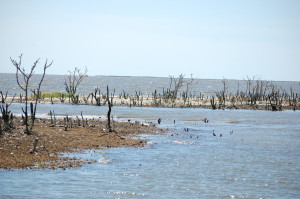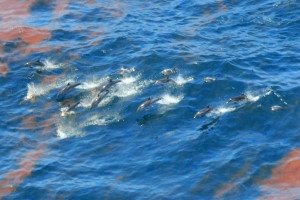We have much more to do and your continued support is needed now more than ever.
Dead Gulf Dolphins, Destroyed Habitat Not BP’s Fault, Says BP

Gulf Still Struggling
As the fourth anniversary of the Deepwater Horizon oil rig explosion approaches, the National Wildlife Federation has issued an assessment of the latest science on oil impacts in the Gulf of Mexico:
- There is strong evidence that the ongoing illness of dolphins in a heavily oiled section of Louisiana is related to oil exposure.
- Roughly five hundred dead sea turtles have been found every year for the past three years in the area affected by the spill—a dramatic increase over normal rates.
- Sperm whales in the Gulf of Mexico have higher levels of DNA-damaging metals than sperm whales elsewhere in the world—metals that were present in oil from BP’s well.
We also took some reporters on a boat tour of the impacted areas in Louisiana’s Barataria Bay, hit hard by the BP oil. As you can see at right, today Cat Island is almost completely stripped of vegetation. For comparison, here’s what Cat Island looked like back in 2010, with thriving mangroves and a bustling rookery for pelicans, roseate spoonbills and other birds. Without the mangrove trees to hold the sand in place, some islands themselves are now beginning to wash away – gone for good.
BP Attacks NWF
For simply pointing out the ongoing impacts of the Gulf oil disaster, BP is now lashing out at us:
BP came out swinging at the National Wildlife Federation for its report on Gulf species allegedly damaged by the Deepwater Horizon oil spill, and has taken strong issue with an environmental tour last week that the group sponsored in Barataria Bay.
A Tri-Parish Times reporter and a photographer were among the media representatives who traveled on the tour, which included stops at a pelican rookery and damaged barrier islands denuded of mangroves.
“The only thing this marsh tour illustrates is how little interest some advocacy groups have in telling the truth about the state of the Gulf’s recovery,” said Jason Ryan, a BP spokesman.
The section I’ve bolded above tells you just how deep BP’s denial goes – any damage at all is now “allegedly.” BP is now trying to turn wildlife impacts into a controversial topic that must be reported as a he said/she said issue, using its muscle and media connections to try to silence any organization or scientist who says otherwise.
How basic are the facts that BP is trying to turn into a controversy? Veteran journalist Bob Marshall has been reporting exactly the same damage to Cat Island. Local fishermen still see the damage every day:
Fishermen at the Myrtle Grove Marina south of New Orleans say despite a massive clean-up effort, Barataria Bay is still hurting.
“There are some areas that we may stay away from just because we know about tar balls popping up and this and that and we really don’t even visit those areas any longer,” said charter boat captain Chad Breland. “Sometimes you have to find new locations to fish. You may have to burn a lot more fuel. You may have to fish different places.”
BP is following the Exxon Valdez playbook – do what you can to look like you care, but always remember the top priority is protecting corporate profits by minimizing legal liability.

Denying Responsibility for Dolphin Deaths
From first days of the spill, BP tried to hide the massive amount of oil gushing from the Deepwater Horizon site. As the disaster continued to unfold, the New York Daily News reported BP was trying to keep reporters away from oiled dead dolphins. Now BP is now telling reporters that there’s no real evidence that dolphins were affected by the oil.
But here’s what the science tells us about dolphins in a heavily-oiled section of the Louisiana coast, according to a NOAA study just released in December 2013:
Bottlenose dolphins in Louisiana’s Barataria Bay have lung damage and adrenal hormone abnormalities not previously seen in other dolphin populations, according to a new peer-reviewed study published Dec. 18, 2013 in the journal Environmental Science & Technology. […]
For Dr. Lori Schwacke, the study’s lead author and veteran of a number of similar dolphin health studies across the southeast, the findings are troubling: “I’ve never seen such a high prevalence of very sick animals — and with unusual conditions such as the adrenal hormone abnormalities.”
The [Natural Resource Damage Assessment] researchers found that moderate to severe lung disease was five times more likely in the Barataria Bay dolphins, with symptoms including lung masses and consolidation. The researchers also found that 25 percent of the Barataria Bay dolphins were significantly underweight and the population overall had very low levels of adrenal hormones, which are critical for responding to stress.
NOAA has now expanded its study of live dolphins to waters in Mississippi and Alabama as part of its effort to understand why dolphins across the northern Gulf of Mexico—the area affected by the oil—have been dying in high numbers since February 2010.
For the truth about the state of the Gulf, watch this National Wildlife Federation video:
[youtube]https://www.youtube.com/watch?v=BSemeLtri3o[/youtube]
If you listened to BP on April 24, 2010, there was a small problem in the Gulf of Mexico and about 42,000 gallons of oil were leaking every day. Turns out, it was probably more like 2.2 million gallons a day. But four years later, BP wants you to think that Gulf has is healthy and only “isolated” areas are still at risk. We can’t trust BP – but we can ask the government to make BP pay for the damage it’s done.
Ask the U.S. Secretary of Commerce to hold BP fully accountable and to make sure BP fines are used to help dolphins and restore their habitat.






















